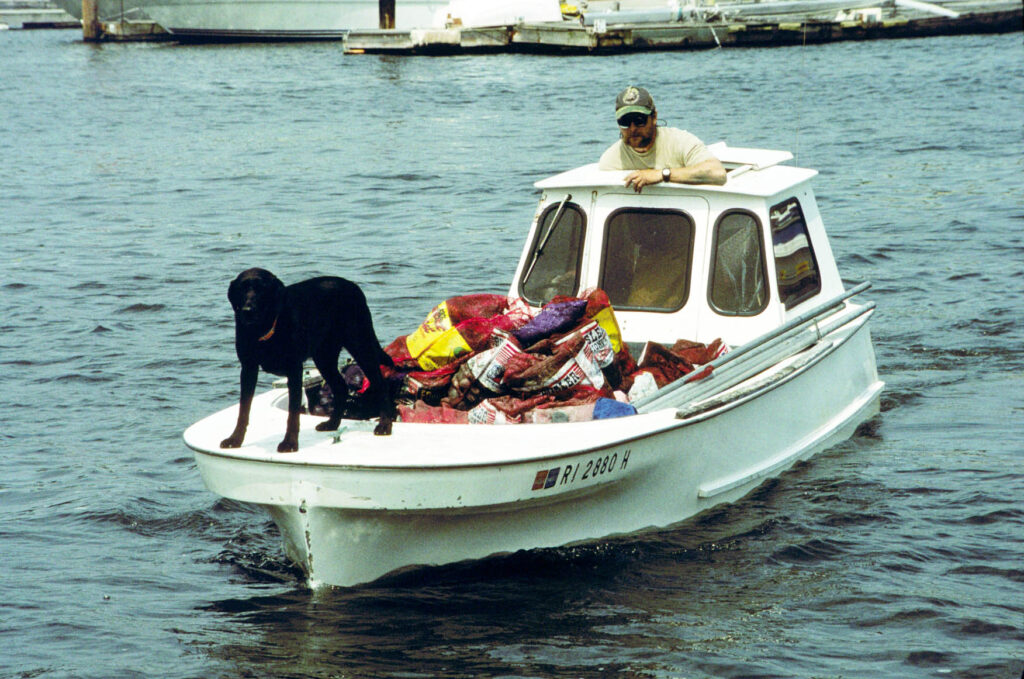A man and his dog deliver hundreds of pounds of quahogs dug up by local shellfishermen for transplant to quahog spawner sanctuaries off the Sakonnet River and outer Greenwich Bay in this photo taken in spring 1997. The sanctuaries were established to compensate for injuries to shellfish after the 1989 World Prodigy oil spill in Narragansett Bay. (NOAA Restoration Center, Louise Kane)
A new report calls for expanding a seven decade-old program for transplanting quahogs in Narragansett Bay to ensure Rhode Island’s official state shell doesn’t disappear.
But the report by the joint legislative study commission studying the quahog’s decline does not recommend increasing nitrogen discharges from wastewater treatment facilities during the winter.
The report published May 31 calls on lawmakers to increase funding for the state-funded Shellfish Transplant Program — which involves moving shellfish from waters that are closed off due to pollution into other areas where commercial harvesting is permitted.
Transplanting shellfish is a practice that began in 1954 and has occurred annually in Rhode Island since the late 1970s, with funding provided by fines levied on municipal wastewater treatment facilities. The Rhode Island Department of Environmental Management (DEM) estimates that increasing transplant frequencies would cost the state up to $200,000, DEM Programming Services Officer Evan LaCross said in an email Monday afternoon.
“Obviously, we’re reviewing everything,” Rep. Joseph Solomon, a Warwick Democrat who co-chaired the commission, said in an interview Monday. “There’s a lot of funding that still needs to be determined.”
Increasing nitrogen discharges was among the top suggestions from the Rhode Island Shellfisherman’s Association to increase the state’s quahog population. The idea to explore additional nitrogen discharges into the bay was first floated by University of Rhode Island (URI) ecologist Candace Ann Oviatt when the commission met last November. Oviatt said in an interview Monday that a small increase in nitrogen during the winter would help fertilize more phytoplankton that feed quahogs during the early spring.
Shellfishermen, DEM officials at odds over increasing nitrogen discharges in bay to feed quahogs
“When the quahogs wake up and start to feed, they can feed much more extensively for a longer period of time if the bloom is very generous to them,” Oviatt said.
“Even though there are indications there may be other causes for the increasing reduction of quahog production, we feel increasing nutrients would have positive effects,” Jim Boyd, one of four shellfishermen who serve on the 13-member commission, said in a statement Sunday.
The joint commission is still open to the association’s proposal, as the report asks DEM to “potentially develop a plan” to modify the discharge permits for the major wastewater treatment facilities along the Providence and Seekonk rivers. Planning would begin either some time this year or in 2025 and include collaboration between the DEM, wastewater treatment facility operators, shellfishermen, and university researchers.
“So many times we see a lot of data, a lot of research, but often one person is not sharing with the other,” Solomon said. “This puts every researcher in the room rather than duplicating efforts.”
But the DEM has no immediate plans to modify nitrogen limits in the discharge permits, LaCross said.
“Instead, DEM will focus its efforts on the other recommendations in the report, including but not limited to, seeking funding for a sustained quahog seeding and transplant program and establishing additional spawner sanctuaries,” he said.
Any potential changes would likely be evaluated when nitrogen discharge permits are reissued, which LaCross noted is scheduled from 2025 to 2027.
But the DEM and environmental advocates warn changing the state’s nitrogen rules may produce unwanted results.
“Increasing nitrogen discharges could undermine progress made in improving bay water quality and habitat, and are potentially illegal under the Clean Water Act,” Save the Bay Narragansett Baykeeper Mike Jarbeau, who served on the commission, said in an emailed statement Monday.
Oviatt said she understands advocates’ hesitation over the proposal, but contends it would not harm the bay based on the past flushing rate of the bay. More research is needed before the state moves forward on updating its discharge regulations, she said.
“It might work, and I don’t think we know that it does until we can study the effects it would have on quahog’s condition directly in the field,” Oviatt said. “I think that the quahog commission came down on the right side of this.”
Additional recommendations from the joint commission include establishing more spawning sanctuaries, increasing state and federally funded monitoring programs and the creation of a permanent Quahog Advisory Commission.
“The report will be used as a starting point,” House spokesperson Larry Berman said. “We will be watching for more action next year.”
GET THE MORNING HEADLINES DELIVERED TO YOUR INBOX
The post Commission calls for expanding quahog transplant program, rejects call for more nitrogen discharges appeared first on Rhode Island Current.

